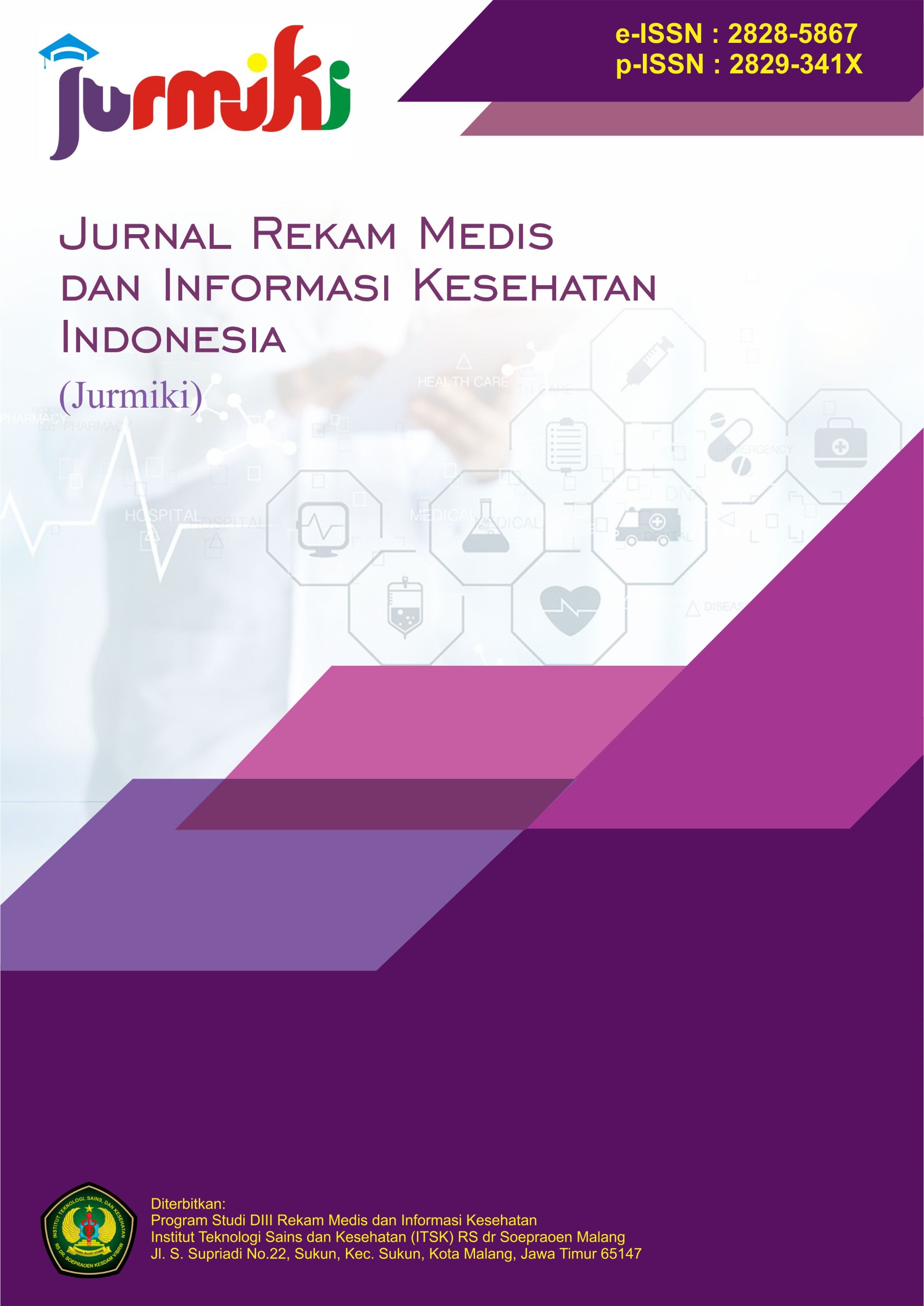Analysis of Electronic Medical Record Implementation Based on HOT- FIT Factors at Ngebel Health Center, Ponorogo Regency
DOI:
https://doi.org/10.62951/jurmiki.v4i2.95Keywords:
Healthcare Services, HOT-FIT, Implementation, Medical RecordAbstract
The implementation of Electronic Medical Records (EMR) is a requirement in the digital transformation of healthcare services in accordance with the Indonesian Ministry of Health Regulation No. 24 of 2022. However, EMR implementation still faces several obstacles in healthcare facilities, including at the Ngebel Public Health Center in Ponorogo Regency. This study aims to analyze the implementation of EMR based on the HOT-FIT framework, which includes four components: Human resources (Human), Organization, Technology, and Net Benefits.This research uses a qualitative descriptive approach with analysis based on the HOT-FIT framework. Data collection techniques include observation, interviews, and documentation. The subjects of this study were seven EMR users.The results show that the EMR has been implemented at the Ngebel Public Health Center since April 2023. The implementation process has been fairly good, however, challenges remain, such as internet connectivity issues and limitations in system features.This study recommends improving internet infrastructure to optimize the benefits of health services, as well as adding a digital signature (TTE) feature to the EMR system at the Ngebel Public Health Center.
References
Apriliyani, S. (2021). The use of electronic medical records to support the effectiveness of outpatient registration at Dr. Ranny's Clinic. Indonesian Scientific Journal, 1(10), 1399–1410. https://doi.org/10.59141/cerdika.v1i10.209
Azwar, S. (2013). Metode penelitian. Yogyakarta: Pustaka Pelajar.
Bernard, H. R. (2002). Research methods in cultural anthropology: Qualitative and quantitative. AltaMira Press.
Department of Health Republic of Indonesia. (2006). Guidebook for the implementation of hospital medical records. In Guidelines for the organization and procedures of Indonesian hospital medical records revision II (p. 203).
Dewi, N. F., Grataridarga, N., Setiawati, R., & Syahidah, Q. N. (2020). Identification of completeness of outpatient medical record metadata filling at RSIA Bunda Aliyah Depok. Journal of Applied Business Administration, 2(2), 103–112.
Handayani, R. (2020). Social research methodology. Yogyakarta: Trussmedia Grafika.
Handiwidjojo, W. (2009). The development of electronic medical record technology in hospitals. Duta Wacana Christian University, 2(1), 36–41. https://media.neliti.com/media/publications/79132-ID-rekam-medis-elektronik.pdf
Indonesian Ministry of Health. (2018). Health research methodology. Jakarta.
Indonesian Ministry of Health. (2022). Regulation of the Minister of Health Number 24 of 2022 concerning medical records (pp. 1–20). https://peraturan.bpk.go.id/Details/245544/permenkes-no-24-tahun-2022
Indonesian Ministry of Health. (2024). Regulation of the Minister of Health Number 19 of 2024 concerning the implementation of community health centers. https://peraturan.bpk.go.id/Details/312837/permenkes-no-19-tahun-2024
Izza, A. A., & Lailiyah, S. (2024). Literature review: An overview of electronic medical record implementation in Indonesian hospitals based on Permenkes Number 24 of 2022 concerning medical records. Media Gizi Kesmas, 13(1), 549–562. https://doi.org/10.20473/mgk.v13i1.2024.549-562
Kesuma, S. I. (2023). Electronic medical records in hospital services in Indonesia: Legal aspects and implementation. ALADALAH: Journal of Politics, Social, Law and Humanities, 1(1), 195–205. https://doi.org/10.59246/aladalah.v1i1.188
Mubarak, W. I. (2014). Public health science concepts and applications in midwifery. Jakarta: Salemba Medika.
Nur Fadhilla, S. A. (2020). Evaluation of health information systems using the HOT-FIT method in supporting the implementation of electronic medical records at the Mnguharjo Lung Hospital Madiun. Scientific Writing, 40–45.
Nurazmi, P., Deharja, A., & Pandeangan, J. (2020). Review of the implementation of maintenance of medical record documents. J-REMI: Journal of Medical Records and Health Information, 2(1), 107–113.
Putri, A. T. D. (2023). Challenges in implementing electronic medical records in Indonesian healthcare facilities. Jurnal Medika Hutama, 4(3), 3427–3431. https://www.jurnalmedikahutama.com/index.php/JMH/article/download/632/441
Republic of Indonesia Ministry of Health. (2008). Regulation of the Minister of Health No. 269/MENKES/PER/III/2008 concerning medical records. https://peraturan.bpk.go.id/Home/Details/133492/permenkes-no-269menkesperiii2008
Rizky, D., & Tiorentap, A. (2020). Benefits of electronic medical record implementation in developing countries: A systematic literature review. Health Information Management Journal, 8(2), 265.
Rusdiana, A. R. I., et al. (2023). Analysis of electronic medical record implementation based on human, organization and technology-benefit (HOT-FIT) factors. Jurnal Rekam Medis, 20(2), 108–126. http://repositori.unsil.ac.id/12288/
Sugiyono. (2017). Quantitative, qualitative, and R&D research methods. Bandung: Alfabeta.
Sugiyono. (2018). Quantitative, qualitative, and R&D research methods. Bandung: Alfabeta.
Tawar, Santoso, A. F., & Salma, Y. S. (2022). HOT-FIT model in information system management. Science and Technology Talk, 1(2), 76–82. https://doi.org/10.56741/bst.v1i02.144
World Health Organization. (2016). Global diffusion of eHealth: Making universal health coverage achievable. Report of the third global survey on eHealth. https://www.who.int/gho/goe/electronic_health_records/en/
Yusof, M., Kujis, J., Papazafeiropoulou, A., & Stergioulas, L. (2006). An evaluation framework for health information system: Human, organization and technology-fit (HOT-fit) factors. International Journal of Medical Informatics, 77(6), 386–398. https://doi.org/10.1016/j.ijmedinf.2007.08.011
Yusof, M., Kujis, J., Papazafeiropoulou, A., & Stergioulas, L. (2008). An evaluation framework for health information system: Human, organization and technology-fit (HOT-fit) factors. International Journal of Medical Informatics, 77(6), 386–398. https://doi.org/10.1016/j.ijmedinf.2007.08.011
Downloads
Published
Issue
Section
License
Copyright (c) 2025 Jurnal Rekam Medis dan Informasi Kesehatan Indonesia

This work is licensed under a Creative Commons Attribution-ShareAlike 4.0 International License.








